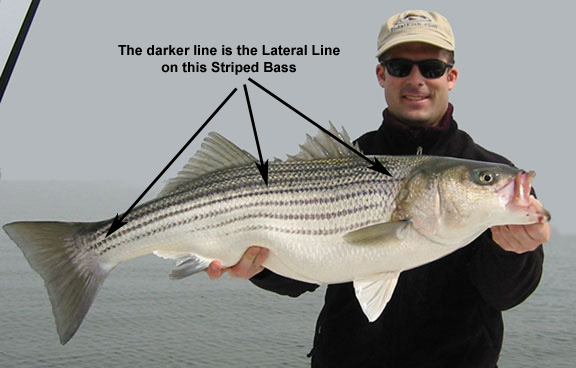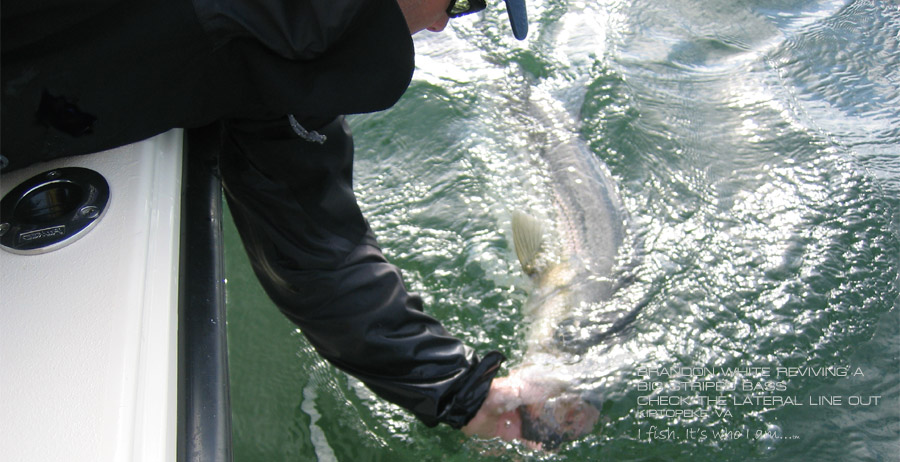 A
lateral line is a sense organ fish use to detect movement and vibration in the surrounding water. They use it to detect depth/water pressure, prey, pretators, sense current movement and orientation in the current, as well as to avoid collisions. It essentially is a form of eyes, ears and sensory feelings combined into one organ. All fish have some form of a lateral line, some having a more developed one then others. Lateral lines are usually visible as faint lines running lengthwise down each side, from the vicinity of the gill covers to the base of the tail. Sometimes parts of the lateral organ are modified into electroreceptors, which are organs used to detect electrical impulses. It is possible that vertebrates, such as sharks, use the lateral organs to detect magnetic fields as well. Most amphibian larvae and some adult amphibians also have a lateral organ. A
lateral line is a sense organ fish use to detect movement and vibration in the surrounding water. They use it to detect depth/water pressure, prey, pretators, sense current movement and orientation in the current, as well as to avoid collisions. It essentially is a form of eyes, ears and sensory feelings combined into one organ. All fish have some form of a lateral line, some having a more developed one then others. Lateral lines are usually visible as faint lines running lengthwise down each side, from the vicinity of the gill covers to the base of the tail. Sometimes parts of the lateral organ are modified into electroreceptors, which are organs used to detect electrical impulses. It is possible that vertebrates, such as sharks, use the lateral organs to detect magnetic fields as well. Most amphibian larvae and some adult amphibians also have a lateral organ.
The lateral line system is a collection of small mechanoreceptive patches or neuromasts located superficially on the skin or just under the skin in fluid-filled canals on the head and body of all fishes. The mechanoreceptive component of the neuromast is the hair cell - the same sensory cell found in all vertebrate ears, including the human ear. The hairs are surrounded by a protruding jelly-like cupula, typically 1/10 to 1/5 mm long. The hair cells and cupolas of the neuromasts are usually at the bottom of a visible pit or groove in the fish.These cells transduce mechanical energy into electrical energy when their apical hairs or "cilia" are displaced. The nerves contacting these receptors enter the brain in close association with the auditory processing areas of the fish nervous system. Although auditory and lateral line pathways in the central nervous system are separate, they are largely parallel and share many of the same organizational features, suggesting that the two systems have developed and evolved in close association with each other and may share common principles of operation.
Teleosts (the classifiction of fish described as ray finned such as a yellow perch) and elasmobranchs (the classification of fish that includes the great white shark and is distinguised from other classes in that they have no swim bladders, five to seven pairs of gill clefts opening individually to the exterior, rigid dorsal fins, and small placoid scales) and usually have lateral-line canals, in which the neuromasts are not directly exposed to the environment, but communicate with it via canal pores. Additional neuromasts may appear individually at various locations on the body surface.
The development of the lateral-line system depends on the fish's mode of life. For instance, fish that are active swimming types tend to have more neuromasts in canals than they have on their surface, and the line will be farther away from the pectoral fins, which probably reduces the amount of "noise" that is generated by fin motion.
The lateral-line system helps the fish to avoid collisions, to orient itself in relation to water currents, and to locate prey. For instance, blind cavefish have rows of neuromasts on their heads, which appear to be used to precisely locate food without the use of sight; killifish are able to use their lateral line organ to sense the ripples made by insects struggling on the water's surface. Experiments with pollock have shown that the lateral line is also a key enabler for schooling behavior. |


